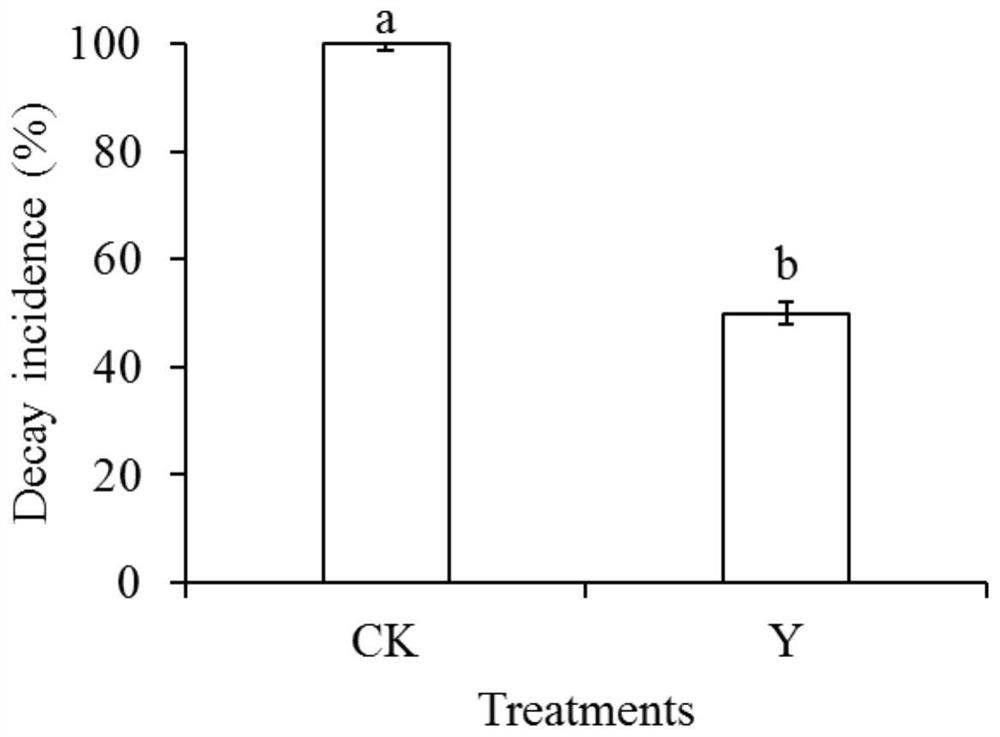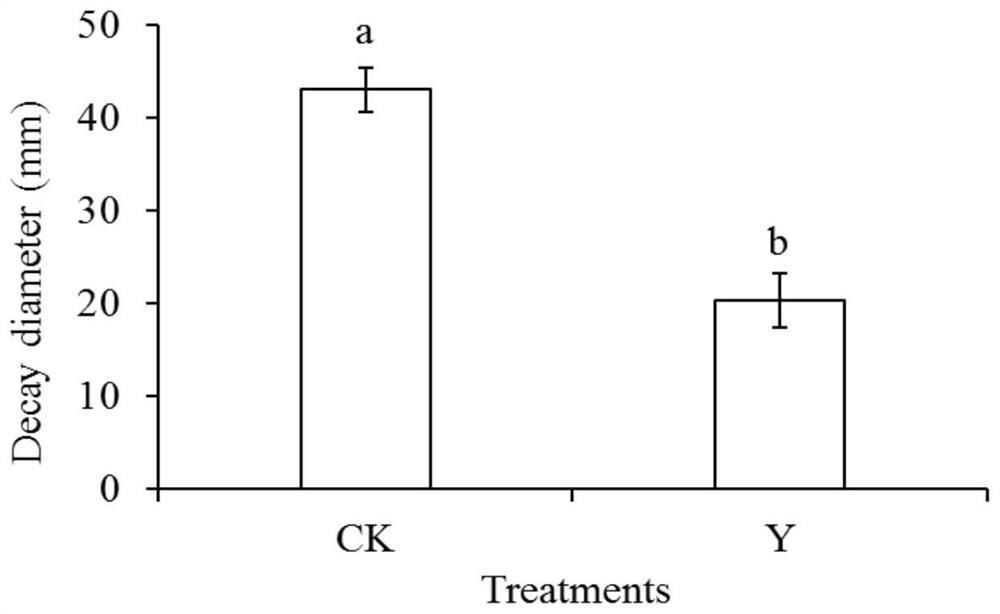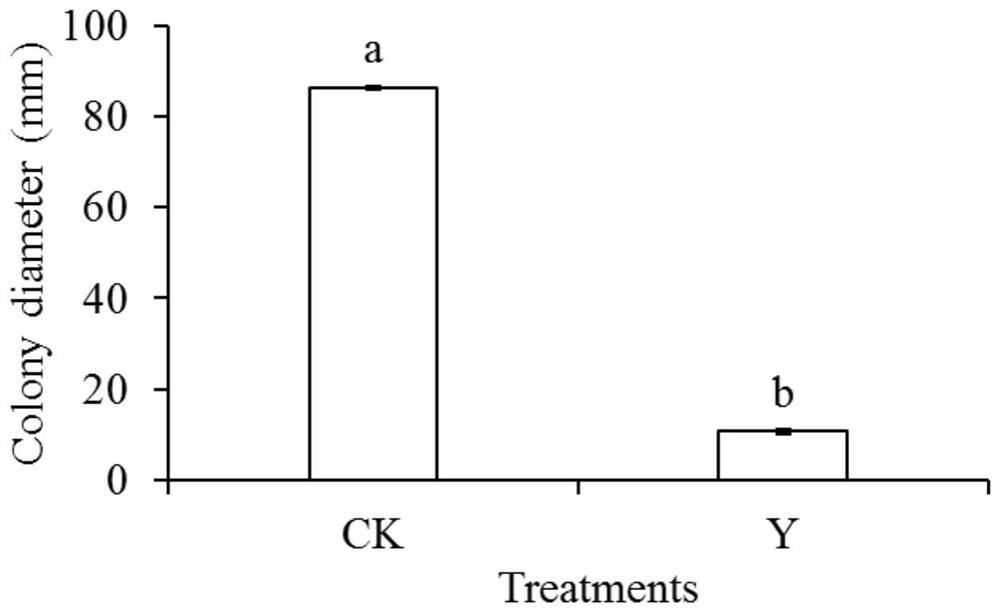Application of Wickerhamomyces anomalus in postharvest disease control, storage and fresh-keeping of tomatoes
A Wickham, storage and fresh-keeping technology, applied in the field of biological control of postharvest diseases of fruits and vegetables, can solve the problems of in-depth research, incomplete research, and further improvement of control effects, so as to avoid harm, reduce losses, and reduce natural rot rate effect
- Summary
- Abstract
- Description
- Claims
- Application Information
AI Technical Summary
Problems solved by technology
Method used
Image
Examples
Embodiment 1
[0025] Inhibitory effect of Saccharomyces anomus against Botrytis cinerea.
[0026] (1) Preparation of yeast suspension
[0027] Inoculate the yeast preserved on the slant into a 250mL Erlenmeyer flask containing 50mL of sterilized NYDB medium, and incubate at a constant temperature of 28°C at 180 rpm for 13 hours, then take 1mL of the fermentation broth into a new sterilized 50mLNYDB In a 250mL Erlenmeyer flask with culture medium, centrifuge the fermentation broth at 7500 rpm for 10 minutes, collect the bacteria, and wash the bacteria twice with sterile water; count with a hemocytometer and adjust the concentration of the yeast suspension to 1× 10 8 cells / mL, ready for use.
[0028] (2) Preparation of Botrytis cinerea spore suspension
[0029] Scrape spores from Botrytis cinerea plates that had been cultured on PDA medium for 7 days at 28°C and suspend them in sterile water, count them with a hemocytometer and adjust the concentration to 1×10 5 spores / mL, ready for use. ...
Embodiment 2
[0036] Controlling effect of Wickham anomalis on rot diameter of tomato Botrytis cinerea.
[0037] The preparation of yeast suspension and Botrytis cinerea spore suspension was the same as in Example 1.
[0038] Tomato pretreatment is the same as above, after 4 days of cultivation, the fruit rot diameter is recorded, so as to evaluate the control effect of abnormal Wickham on the rot diameter of tomato Botrytis cinerea.
[0039] According to the above steps, the control effect of abnormal Wickham yeast on the rot diameter of tomato botrytis cinerea is as follows: figure 2 shown.
[0040] From figure 2 It can be seen that the rot diameter of the tomato fruit inoculated with the abnormal Wickham yeast is significantly smaller than that of the tomato fruit not inoculated with the yeast. When the tomato rot caused by botrytis cinerea in the control group reached 43 mm, the rot diameter of the tomato inoculated with abnormal Wickham yeast was only 20 mm, which was significantl...
Embodiment 3
[0042] Inhibitory effect of Saccharomyces anomus on PDA against Botrytis cinerea.
[0043] The preparation of yeast suspension and Botrytis cinerea spore suspension was the same as in Example 1.
[0044] Pour 40mL of sterilized PDA medium into a sterile petri dish. After solidification, punch a 10mm hole in the center of the petri dish with a sterile puncher, and inject 100μL of 1×10 into each hole. 8 Abnormal Wickham yeast suspension in cells / mL. After 2 hours, add 100 μL of Botrytis cinerea spore suspension (1×10 5 spores / mL) into each well. After waiting for 2 hours, wrap the plate with a fresh-keeping bag and place it in a constant temperature and humidity incubator (20°C, RH 95%) for cultivation. After 5 days, observe the growth of the mold and measure the diameter of the lesion. Each treatment contained 3 parallels, and the entire experiment was repeated twice.
[0045] Test according to the above steps, the inhibitory effect of abnormal Wickham yeast on PDA to Botry...
PUM
 Login to View More
Login to View More Abstract
Description
Claims
Application Information
 Login to View More
Login to View More - R&D
- Intellectual Property
- Life Sciences
- Materials
- Tech Scout
- Unparalleled Data Quality
- Higher Quality Content
- 60% Fewer Hallucinations
Browse by: Latest US Patents, China's latest patents, Technical Efficacy Thesaurus, Application Domain, Technology Topic, Popular Technical Reports.
© 2025 PatSnap. All rights reserved.Legal|Privacy policy|Modern Slavery Act Transparency Statement|Sitemap|About US| Contact US: help@patsnap.com



